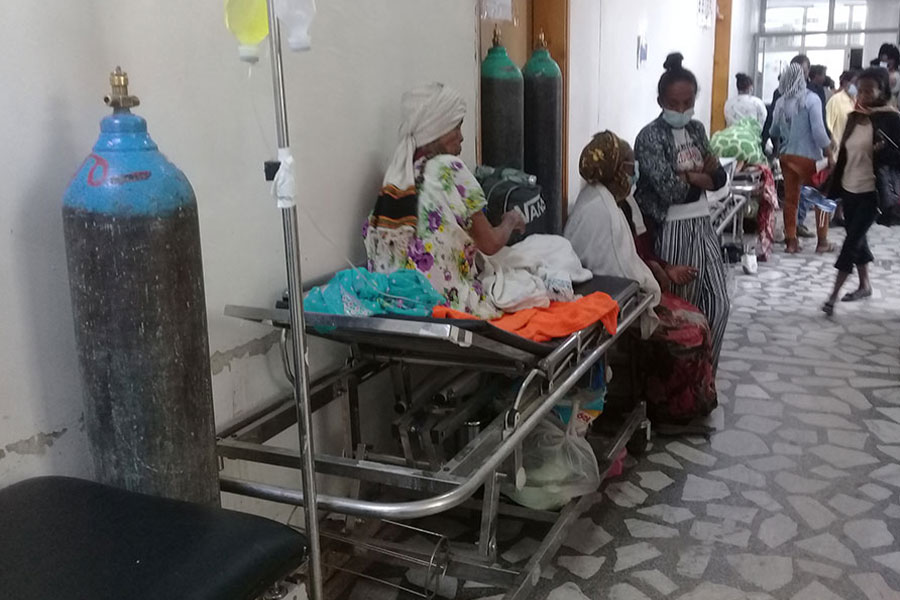
Commentaries | Jun 04,2022
Nov 13 , 2021
By Yeraeifirae Sileshi (MD)
Hospitals and insurance companies should come together and map out a shared future. Private insurance companies are the way going forward, writes Yeraeifirae Sileshi (MD) (mulatawaji@gmail.com), CEO of Saglan Wajee General Hospital.
Let us all agree on one point. For a successful economy, a successful health care system is mandatory. It is also a showcase of a successful economy. Only healthy individuals can be productive.
In 1929, during the famous Great Depression of the United States, Justin Kimble, the administrator of Baylor University Hospital, devised a means for people to pay for hospital care. He enrolled 1,250 public schoolteachers into the Baylor Plan. For 50 cents a month, he promised to provide 21 days of care in his hospital.
Like all good ideas, this became a solution to a problem. The Great Depression affected all sectors of the economy, including the health sector. Spending for health dwindled from 236 dollars to 59 dollars a patient, occupancy rates dropped from 71.3pc to 64.1pc, and contributions were down by two-thirds. Charity care, in contrast, was up 400 percent.
This is what gave birth to the Baylor Plan. This went as a means to keep giving healthcare, during the challenging times of a shaken economy. Born out of a problem, the solution lasted generations, giving birth to the biggest health care industry in the world.
For all its flaws and political debates, the American Health Insurance system still provides quality care with affordable premium payments. This has helped increase the capacity of private hospitals by creating a proper channel for patients as well as curbing the issue of affordability. This in turn significantly increased the medical and pharmaceutical manufacturing sector.
Though the historical background is different, the Chinese basic health insurance system covers more than 95pc of the population. It is viewed as one of the most successful insurance schemes in the world, with low premiums and high quality of medical service. It has a well-developed chain of primary to tertiary care.
One of the reasons that allowed the Chinese Health Insurance system to succeed, especially in cities, is the need for mandatory health insurance for all employed citizens. Neighbouring Kenya, which has around 17pc of its population insured, where NHIF is the main health insurer, covers 16pc of citizens. The 32 private health insurers collectively cover a mere one percent of the Kenyan population.
In Ethiopia, although the private health insurance sector has existed for a while, it is still very weak in penetration, mainly due to the distance between the health insurance companies and the hospitals to have a symbiotic relationship that can lead to a managed care system.
On the contrary, the government-led community-based health insurance scheme by EHIA started about a decade ago has been quite a success. Just last year, one of its programmes, the Community Based Health Insurance (CBHI) service, amassed 2.2 billion Br in premiums and paid out about half of that to health institutions.
Contrary to the common belief of most business models, health insurance is mainly based in the rural region. It should be studied why the urban society, which is formally educated, has not been able to be a part of this. On the other hand, the soon to be launched social health insurance will set up good ground for the future of the health care industry,
There will be a number of challenges along the way. Trust is one issue. The relationship between hospitals and insurance companies has not been up to par over the past few years. Insurance companies complain about exaggerated fees from hospitals and go as far as accusations about prescribing unnecessary medicines for the customers. Hospitals on the other hand deny most allegations, and blame insurance companies for late payments and having non-health professionals working in claims departments to properly understand the demands.
All this comes from not coming together around the table and discussing issues as well as forging future strategic moves for the sector. Health insurance can and will be more than an incentive for those working in NGO’s and international companies. It will be for my family and that of everyone else. It will be a Plan B if Plan A fails, which is to be healthy at all times.
Neither is community acceptance an easy thing to achieve. Thanks to the Ethiopian Health Insurance Service, the awareness in communities about the importance of health insurance is quite exemplary, especially the moment one steps foot out of Addis Abeba. But, there still lies unawareness about the benefits of health insurance in urban cities throughout the country. This can easily be done through different social mobilisations.
But the fact that there are challenges does not rule out the possibility of prospects. To start with, there are many promising policies and regulations. The social health insurance to be launched by the Insurance Service entails that it will initially create a pilot project, where willingly, six percent of employee’s salary (the contribution shared equally with the employer) will be used to buy health insurance. If the government makes it mandatory, the same way one pays for pension or income tax, it can significantly boost the number of premium subscribers. There should be an effort from the Ethiopian Insurance Association to push for the inclusion of the private health sector in this scheme, similar to third-party vehicle insurance.
Technological advances are also more likely to make wider health insurance coverage a possibility. Long queues at the bank, manual paperwork and bureaucratic reimbursements are not encouraging for anyone. Insurance companies should integrate emerging mobile payment methods to make it a process that only takes a few minutes from registration as a new member to paying one's annual renewal fees. Further integrations are also being made by Korenti Health, a local Tech Company, to digitise registration, claim support and analysis, expiration dates, available hospital lists and other vital components needed for the customer, hospital and insurance company.
The competition in the health sector is also encouraging. Although still not enough, the past five years has seen a dramatic increase in health care facilities. Most hospitals invest more than 150 million Br on average to get a state of art facility and equipment. This results in higher expenditure when patients access the hospitals for treatment. Most hospitals have an average 25pc occupancy rate mostly attributed to the expenses involved. This puts the already heavily-burdened government hospitals in chaos, which themselves have bumped up prices.
It will also be encouraging that Ethiopia will soon have a health insurance company. The National Bank of Ethiopia (NBE), in its proclamations, states that a General Insurance Company needs 60 million Br in paid-up capital while long-term insurance will only need 15 million Br. To everyone’s amazement, there’s not one insurance company that specialises solely in health coverage.
This is all about to change when the market will have a new player town, Meqrez Health Insurance S.C. It aspires to dive all the way in the health sector, by providing health insurance on one end and constructing health centres on the other. This is an awe-inspiring move, which should have long been taken by well-established hospitals.
What ought to be taken to make private health insurance a success?
In a recent press interview, health sector providers and pharmaceutical importers got together to announce a partnership, so that the latter can import COVID-19 Sinopharm vaccines and the providers to take care of its administration. This marks a new era, from the much talked about Public-Private Partnership (PPP) to a Private-Private Partnership. Although there is a minimal practice in that field, perhaps only limited to medical imaging, such partnerships are crucial to increase the quality and rapid expansion of health care facilities and services.
Hospitals and insurance companies should come together and map out a shared future, whether in lobbying efforts that affect both sectors, commencing new projects or even creating new health insurance companies together.
PUBLISHED ON
Nov 13,2021 [ VOL
22 , NO
1124]


Commentaries | Jun 04,2022

Radar | Oct 23,2021

Radar | Nov 20,2021

News Analysis | May 06,2023

Radar | May 18,2024

Viewpoints | Apr 03,2021

Fortune News | May 18,2019

Radar | Apr 20,2019

My Opinion | Apr 20,2024

Commentaries | Sep 06,2025

Photo Gallery | 178504 Views | May 06,2019

Photo Gallery | 168700 Views | Apr 26,2019

Photo Gallery | 159512 Views | Oct 06,2021

My Opinion | 137080 Views | Aug 14,2021
Commentaries | Oct 25,2025

Dec 22 , 2024 . By TIZITA SHEWAFERAW
Charged with transforming colossal state-owned enterprises into modern and competitiv...

Aug 18 , 2024 . By AKSAH ITALO
Although predictable Yonas Zerihun's job in the ride-hailing service is not immune to...

Jul 28 , 2024 . By TIZITA SHEWAFERAW
Unhabitual, perhaps too many, Samuel Gebreyohannes, 38, used to occasionally enjoy a couple of beers at breakfast. However, he recently swit...

Jul 13 , 2024 . By AKSAH ITALO
Investors who rely on tractors, trucks, and field vehicles for commuting, transporting commodities, and f...

Oct 25 , 2025
The regulatory machinery is on overdrive. In only two years, no fewer than 35 new pro...

Oct 18 , 2025
The political establishment, notably the ruling party and its top brass, has become p...

Oct 11 , 2025
Ladislas Farago, a roving Associated Press (AP) correspondent, arrived in Ethiopia in...

Oct 4 , 2025
Eyob Tekalegn (PhD) had been in the Governor's chair for only weeks when, on Septembe...

Oct 25 , 2025 . By YITBAREK GETACHEW
Officials of the Addis Abeba's Education Bureau have embarked on an ambitious experim...

Oct 26 , 2025 . By YITBAREK GETACHEW
The federal government is making a landmark shift in its investment incentive regime...

Oct 29 , 2025 . By NAHOM AYELE
The National Bank of Ethiopia (NBE) is preparing to issue a directive that will funda...

Oct 26 , 2025 . By SURAFEL MULUGETA
A community of booksellers shadowing the Ethiopian National Theatre has been jolted b...